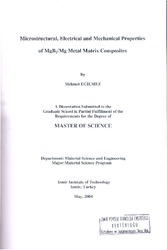Please use this identifier to cite or link to this item:
https://hdl.handle.net/11147/3388Full metadata record
| DC Field | Value | Language |
|---|---|---|
| dc.contributor.advisor | Özyüzer, Lütfi | en |
| dc.contributor.author | Eğilmez, Mehmet | - |
| dc.date.accessioned | 2014-07-22T13:51:26Z | - |
| dc.date.available | 2014-07-22T13:51:26Z | - |
| dc.date.issued | 2004 | en |
| dc.identifier.uri | http://hdl.handle.net/11147/3388 | - |
| dc.description | Thesis (Master)--Izmir Institute of Technology, Materials Science and Engineering, Izmir, 2004 | en |
| dc.description | Includes bibliographical references (leaves: 75) | en |
| dc.description | Text in English; Abstract: Turkish and English | en |
| dc.description | x, 81 leaves | en |
| dc.description.abstract | The recent discovery of superconducting MgB2 (2001) has risen a great interest because of its relatively high Tc (39 K). Furthermore, simple crystal structure, large coherence lengths, high critical current densities (Jc) and critical fields (Bc2), promise that MgB2 will be a good material for large-scale applications based on production of superconducting wires. However, MgB2 is not a stand-alone material to produce wires because of its brittle nature. The potential of MgB2/Mg composites for producing superconducting wires, is investigated. MgB2/Mg composites were prepared using metal matrix composite fabrication technique, which is an alternative to conventional wire fabrication methods such as powder in tube. MgB2 and Mg powders were mixed at different weight fractions and uniaxially pressed in a cylindrical dye under the pressure of 0.5 GPa and 1GPa for two hours at different temperatures in the air. X-Ray Diffraction (XRD), Scanning Electron Microscopy (SEM) and Electron Dispersive X-Ray Spectroscopy (EDX) techniques were used for phase identification and microstructural studies. D.C resistivity measurements were carried on the pellet segments of the MgB2/Mg composites in the temperature range 20-300 K. Magnetization measurements were done on the composites using a vibrating sample magnetometer to characterize the magnetic properties of the samples. The effects of pressing temperature on the mechanical properties of MgB2/Mg composites were also investigated. For this purpose, compressive mechanical testing were performed to measure elastic modulus and strength at failure values of the composites. It was found that the relative weight fractions of Mg and the pressing temperature have some considerable effect on the electrical, magnetic, microstructural and the mechanical properties of the composites. | en |
| dc.language.iso | en | en_US |
| dc.publisher | Izmir Institute of Technology | en |
| dc.rights | info:eu-repo/semantics/openAccess | en_US |
| dc.subject.lcc | TK454.4.S93 .E29 2004 | en |
| dc.subject.lcsh | Superconductors | en |
| dc.subject.lcsh | High temperature superconductors | en |
| dc.subject.lcsh | Superconductivity | en |
| dc.subject.lcsh | Composite materials--Electric properties | en |
| dc.title | Microstructural, electrical and mechanical properties of MgB2/Mg metal matrix composites | en_US |
| dc.type | Master Thesis | en_US |
| dc.institutionauthor | Eğilmez, Mehmet | - |
| dc.department | Thesis (Master)--İzmir Institute of Technology, Materials Science and Engineering | en_US |
| dc.relation.publicationcategory | Tez | en_US |
| item.languageiso639-1 | en | - |
| item.fulltext | With Fulltext | - |
| item.openairecristype | http://purl.org/coar/resource_type/c_18cf | - |
| item.openairetype | Master Thesis | - |
| item.grantfulltext | open | - |
| item.cerifentitytype | Publications | - |
| Appears in Collections: | Master Degree / Yüksek Lisans Tezleri | |
Files in This Item:
| File | Description | Size | Format | |
|---|---|---|---|---|
| T000467.pdf | MasterThesis | 6.28 MB | Adobe PDF |  View/Open |
CORE Recommender
Page view(s)
130
checked on Jul 22, 2024
Download(s)
54
checked on Jul 22, 2024
Google ScholarTM
Check
Items in GCRIS Repository are protected by copyright, with all rights reserved, unless otherwise indicated.